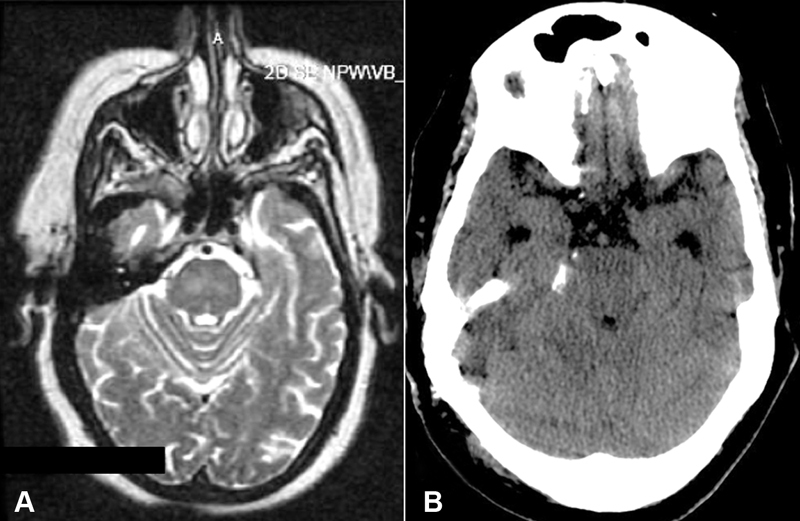Abstract
Trigeminal neuralgia is a chronic pain disorder affecting the face. In approximately 80% of cases, it is most commonly caused, when the root entry zone (REZ) of the trigeminal nerve is compressed by the superior cerebellar artery (SCA). The etiology of the remaining 20% of cases is distributed among venous, arteriovenous malformations, posterior fossa tumors, multiple sclerosis plaque compressions, and other pathologies. Combinations of those compressive factors are very rare. 1 2 3 4 Herein, we present a video clip of microvascular decompression (MVD) in a 73-year-old female, who has failed conservative treatment with 6 medications over 10 years. She was affected by a unique triple compression of the right REZ by the SCA, anterior inferior cerebellar artery (AICA), and petrosal vein complex ( Fig. 1A ). Right-sided microsurgical decompression of the REZ of the trigeminal nerve through standard retrosigmoid craniotomy was performed by the senior author (K.I.A.). The SCA and AICA were separated from the nerve using Teflon pledgets. The petrosal vein complex was coagulated and divided, freeing up the right trigeminal nerve ( Fig. 1B ). The patient was discharged home on the third postoperative day with complete resolution of trigeminal neuralgia.
The link to the Video can be found at: https://youtu.be/PYVvImGW0yE .
Keywords: trigeminal neuralgia, microvascular decompression, suboccipital craniotomy, arterial compression, venous compression
Fig. 1.

( A ) Preoperative T2-weighted axial magnetic resonance imaging (MRI); ( B ) Postoperative noncontrast axial computed tomography (CT) of brain.
www.thieme.com/skullbasevideos
Acknowlegements
No financial or material support was accepted as part of this study. The authors wish to thank Andrew J. Gienapp for copy editing, preparation of the manuscript, and figure for publishing, and publication assistance.
Footnotes
Conflict of Interest None.
References
- 1.Jannetta P J. Arterial compression of the trigeminal nerve at the pons in patients with trigeminal neuralgia. J Neurosurg. 1967;26(01):159–162. doi: 10.3171/jns.1967.26.1part2.0159. [DOI] [PubMed] [Google Scholar]
- 2.Haines S J, Jannetta P J, Zorub D S. Microvascular relations of the trigeminal nerve. An anatomical study with clinical correlation. J Neurosurg. 1980;52(03):381–386. doi: 10.3171/jns.1980.52.3.0381. [DOI] [PubMed] [Google Scholar]
- 3.Arnautovic K I, Husain M M, Linskey M E. Cranial nerve root entry zone primary cerebellopontine angle gliomas: a rare and poorly recognized subset of extraparenchymal tumors. J Neurooncol. 2000;49(03):205–212. doi: 10.1023/a:1006488905526. [DOI] [PubMed] [Google Scholar]
- 4.Greenberg M S. NY: Thieme; 2010. Handbook of Neurosurgery. [Google Scholar]


